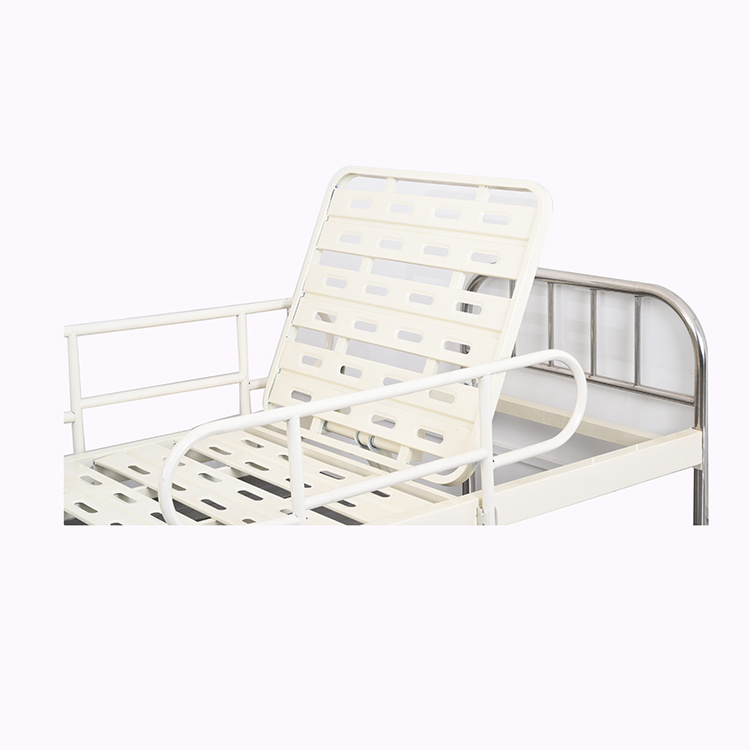What is the structure and performance of the turn-over nursing bed?
Release time:
2023-01-11
Turn-over nursing beds can help patients sit up on their sides, bend their lower limbs, and relieve edema. It is suitable for self-care and rehabilitation of various bedridden patients, and can reduce the nursing intensity of medical staff. It is a new type of multifunctional nursing instrument.

Turn-over nursing beds can help patients sit up on their sides, bend their lower limbs, and relieve edema. It is suitable for self-care and rehabilitation of various bedridden patients, and can reduce the nursing intensity of medical staff. It is a new type of multifunctional nursing instrument.

The main structure and performance of the turn-over nursing bed are as follows:
1. Electric flip
A stack of flip frame assemblies is installed on the left and right sides of the bed board. After the motor is running, the turning frame can be slowly raised and lowered on the left and right sides through slow transmission. The roll-over strap is installed on the roll-over frame. Through the function of the tumbling belt, the human body can roll at any angle within the range of 0-80 °, thereby changing the compressed parts of the body and providing ideal nursing and treatment posture.
2, turn over nursing bed to get up
A pair of lifting arms are arranged below the bed board. After the motor is running, it drives the rising shaft to rotate, so that the arms at both ends of the shaft can move in an arc, so that the bed board can rise and fall at will within the range of 0 ° ~ 80 °, and help the patient to complete sit-ups.
3. Electric-assisted lower limb flexion and extension
A pair of bending and stretching folding pads are fixed on the left and right of the lower bed board, and a pair of sliding rollers are installed on the left and right of the lower end to make the folding pads flexible and light. After the motor runs, it drives the extension and flexion shaft to rotate, so that the wire rope fixed on the shaft is rolled up under the cooperation of the tension spring, and the arc-shaped lifting rod moves up and down, thereby completing the extension and flexion of the employee's lower limbs. It can be stopped and started at will in the height range of 0~280mm to meet the purpose of exercise and recovery of lower limb function.
4. Structure of defecation
The hip of the lower bed board has a rectangular hole with a cover plate, a drawstring is embedded in the cover plate, and a toilet bowl is located at the lower part of the cover plate. The track welded to the bed frame tightly combines the upper hole of the toilet with the cover plate on the lower bed plate. The patient can control the electric leg bending button to get up, adjust the position of the bed, and then pull the cover to complete the bed-wetting process.
5. Activity table
There is a feeling table in the middle of the bed frame. Usually, the table top and the end of the bed are one piece. When in use, the table can be pulled up, and the patient can get up with the help of electricity, and then write, read, eat and other activities.
6. Seat function
The front end of the bed can naturally rise and the back end can naturally fall. The whole bed body becomes a seat, which can meet the leisure needs of the elderly such as sitting and resting, even reading books and watching TV (ordinary nursing beds do not have this function).
7. Shampoo function
The old man had his own shampoo basin under his head when he was lying flat. After removing the pillow, the shampoo basin will be freely exposed. The old man can lie on the bed and wash his hair without moving.
8, sitting foot washing function
A footbath is provided at the bottom of the bed to lift the front of the bed and sink the back of the bed. After the elderly sit up, their calves can sag naturally, which can help them wash their feet easily (equivalent to sitting on a chair), effectively avoid the inconvenience of washing their feet while lying down, and allow them to soak their feet for a long time (common nursing beds do not have this function).
9. Wheelchair function
The patient can sit up at any angle from 0 to 90 degrees. Patients are often sat up to prevent tissue shrinkage and reduce edema. Contribute to the recovery of activity. The patient sat up.
Key words:
Turn-over nursing bed
recommend reading



